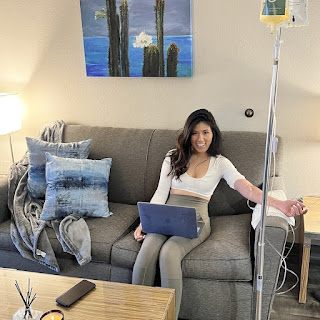What Happens if an IV is Put in Wrong?
Introduction
When it comes to medical procedures, precision is paramount. Intravenous Hangover IV Drip at Home in Dubai (IV) therapy, commonly used to administer fluids, medications, or nutrients directly into the bloodstream, requires careful placement. However, despite the best efforts of healthcare professionals, IVs can sometimes be inserted incorrectly, leading to various complications.
Understanding IV Placement
Types of IV Placements
IV placements can vary based on the patient's condition and treatment needs. Common types include peripheral IVs, central venous catheters (CVCs), and peripherally inserted central catheters (PICCs). Each type has specific insertion sites and considerations.
Importance of Proper IV Placement
Proper IV placement ensures effective delivery of fluids and medications while minimizing risks. It allows for optimal flow rate and reduces the likelihood of complications such as infiltration, infection, or tissue damage.
Consequences of Incorrect IV Placement
Incorrect IV placement can have several adverse effects on the patient's health and well-being.
Pain and Discomfort
One of the immediate consequences of incorrect IV placement is pain and discomfort at the insertion site. Patients may experience a burning sensation, throbbing, or tenderness, indicating that the IV is not properly positioned.
Infiltration and Extravasation
Infiltration occurs when the IV fluid leaks into the surrounding tissue, leading to swelling, redness, and tissue damage. Extravasation is a more severe form of infiltration, where vesicant medications cause tissue necrosis and blistering.
Infection
Improperly placed IVs increase the risk of infection as bacteria can enter the bloodstream through the insertion site. This can lead to localized infections, such as cellulitis, or systemic infections, such as sepsis, posing a serious threat to the patient's health.
Phlebitis
Phlebitis, inflammation of the vein, is another common complication of incorrect IV placement. Symptoms include pain, redness, and swelling along the vein, indicating irritation or damage caused by the IV catheter.
Damage to Surrounding Tissues
Inadequate IV placement can cause damage to surrounding tissues, nerves, or blood vessels, leading to bruising, hematoma, or nerve injury. This can prolong recovery time and require additional medical interventions.
Systemic Effects
In severe cases, incorrect IV placement can have systemic effects, affecting vital organs and bodily functions. Complications such as air embolism, electrolyte imbalances, or circulatory collapse may occur, posing life-threatening risks to the patient.
Identifying Incorrect IV Placement
Early detection of incorrect IV placement is crucial for preventing complications and ensuring prompt intervention.
Signs and Symptoms
Healthcare providers should be vigilant for signs and symptoms indicating improper IV placement, such as swelling, pain, discoloration, or reduced flow rate. Regular assessment of the insertion site is essential for early detection of complications.
Patient Feedback
Patients should be encouraged to communicate any discomfort or unusual sensations associated with the IV placement. Their feedback provides valuable insights into the effectiveness and safety of the procedure.
Monitoring IV Site
Frequent monitoring of the IV site, including visual inspection and assessment of skin integrity, is essential for detecting infiltration, infection, or other complications. Any changes should be promptly reported and addressed by healthcare professionals.
What to Do if an IV is Put in Wrong?
In the event of incorrect IV placement, prompt action is necessary to mitigate risks and ensure patient safety.
Immediate Actions
If an IV is put in wrong, the healthcare provider should immediately stop the infusion and assess the insertion site for signs of complications. The IV catheter may need to be removed and reinserted in a different location to prevent further damage.
Notifying Healthcare Provider
Healthcare providers should be informed of the incorrect IV placement so that appropriate measures can be taken to address the issue. This may involve consulting with a supervisor, ordering diagnostic tests, or initiating treatment for any resulting complications.
Treatment Options
Treatment for complications resulting from incorrect IV therapy Dubai placement depends on the specific nature and severity of the problem. This may include administering antidotes for extravasation, prescribing antibiotics for infections, or providing supportive care to alleviate symptoms.
Preventing Incorrect IV Placement
Prevention is key to reducing the incidence of incorrect IV placement and minimizing associated risks.
Proper Training and Certification
Healthcare professionals should undergo comprehensive training and certification in IV therapy to ensure competency in insertion techniques, anatomy knowledge, and complication management.
Using Ultrasound Guidance
Ultrasound guidance can improve the accuracy of IV placement, especially in challenging cases or patients with difficult veins. Real-time imaging helps healthcare providers visualize the vein and guide the insertion process with precision.
Following Protocols and Guidelines
Adhering to established protocols and guidelines for IV placement reduces variability and standardizes practice across healthcare settings. This includes proper site selection, vein assessment, catheter size selection, and post-insertion care.
Conclusion
Correct IV placement is essential for safe and effective patient care. When an IV is put in wrong, it can lead to various complications, ranging from minor discomfort to life-threatening emergencies. Healthcare providers must be vigilant in monitoring IV sites, promptly identifying and addressing any issues to prevent adverse outcomes.


Comments
Post a Comment